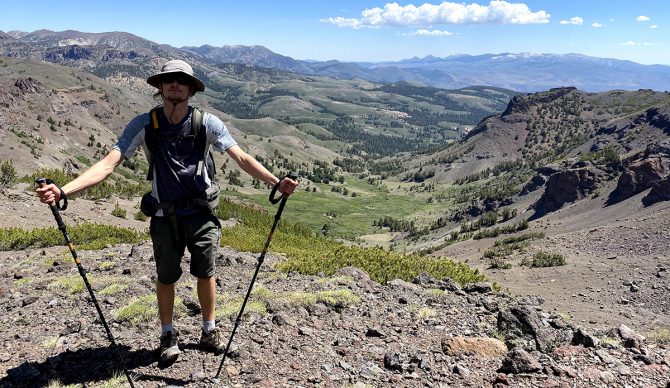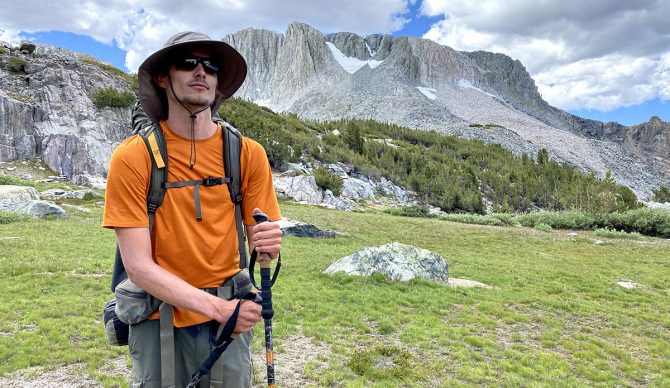
The author isn’t concerned with aesthetics. Poles work for him. Photo: EQ
“I’m young and in shape, I don’t need hiking poles.” That’s what I always told myself as my passion for hiking began to boom in my early twenties. As I began embarking on longer and more strenuous hikes, getting more experienced with multiple-day backpacking trips, I never considered bringing poles. One of my hiking buddies had a bad knee, so he always used poles, but me, I had no injury history. Why would I bother?
Then I tried hiking poles for the first time and the difference was game-changing. I’d been flat-out wrong about poles. While they could turn a tricky stream crossing into a piece of cake and greatly stabilize balance in snowy conditions, the biggest selling point for me was the increased endurance. Now I won’t go anywhere without them.
Back in 2019, I was planning a springtime, five-day trek across Zion National Park. In late March, there was going to be snow on the ground at higher elevations, so I figured I’d pick up some hiking poles for extra balance in case there were any dicey sections. Well, right before the hike Utah received a late-season dumping of snow which caused me and my group to scratch the backpacking plans in lieu of car camping and day hiking.
I still had those poles laying around, so I figured I might as well use them. I debuted the accessories on a fairly moderate hike of about 10 miles and 1,500 feet of elevation gain. When I was done I took off my boots and stretched my body out a bit, surprised with how I felt. I didn’t have the typical levels of soreness and pain that I would expect after a hike of that length. I felt like I could do it again. My knees, my ankles, my hips, my back, were feeling noticeably fresh. Was it the poles?
I kept using the poles, whether day hikes, overnight hikes, steep grades, flat grades, long distance, short distance. My initial findings held true. While the poles weren’t essential, they increased my endurance by taking stress off my lower extremities. I could hike for longer, was less sore, and could hike faster.
So, what was going on in my hiking pole-aided body? It turns out there is some evidence to support what I was feeling.
In late 2020, a review article was released in Wilderness & Environmental Medicine that compiled and analyzed many studies on the topic of hikers using poles. The research suggested several perceived benefits to hiking poles: They reduce fatigue, can improve endurance, make you hike faster, and aid in balance, especially when carrying a large pack load.

Hiking poles…because they work. Photo: EQ
One study showed that hiking poles reduced the force on the lower extremities by 12-16 percent when hiking downhill. Another stated that, in general, 4.4 percent of the stress of pack load was reduced. Also, the research showed that the use of two poles (as opposed to one) was able to improve balance and increase efficiency when wearing a heavy pack.
The article also stated that the use of hiking poles improves your gait, which allows users to walk in a more normal walking pattern. As a result, those who used hiking poles took longer strides and experienced less compression force on their knee joints, leading to faster walking speeds.
But on the other hand, there are those who are skeptical of the benefits of poles. Interestingly, hikers who use poles are shown to burn about 20 percent more calories. That can be seen as a good thing for those looking to get some exercise, or viewed as wasted energy if you’re in for an arduous hike where calories are precious.
The International Mountaineering and Climbing Federation is particularly doubtful about the benefits of poles. They say that your body benefits from balancing on its own and reliance on poles can lead to an increased chance of accidents in areas that are too narrow for poles. And by taking weight off your joints going downhill, you are losing out on important forces that condition and strengthen your knee cartilage.
For me, no matter how you interpret the data in these studies, my personal anecdotal effects of poles have been overwhelmingly positive. I’ve been converted. And at the end of the day, it may come down to what type of a hiker you are, what your goals are, and your unique body type. If you’re going on an endurance trek with limited food and water supply, it might make sense to forgo those extra calories that poles will burn. Or if you have to climb technical boulder sections, the poles could become a nuisance to carry. But if you’re like me, a leisurely backpacker with ample access to food and water, I’ll gladly burn the extra calories to keep my joints and muscles feeling more fresh.
At 32 years old now, I’m a hiking pole advocate. Everyone, young and old, should at least give them a try. And I don’t care how fashionable (or unfashionable) they are. For me they’ve been borderline revolutionary and I don’t hike without them.

